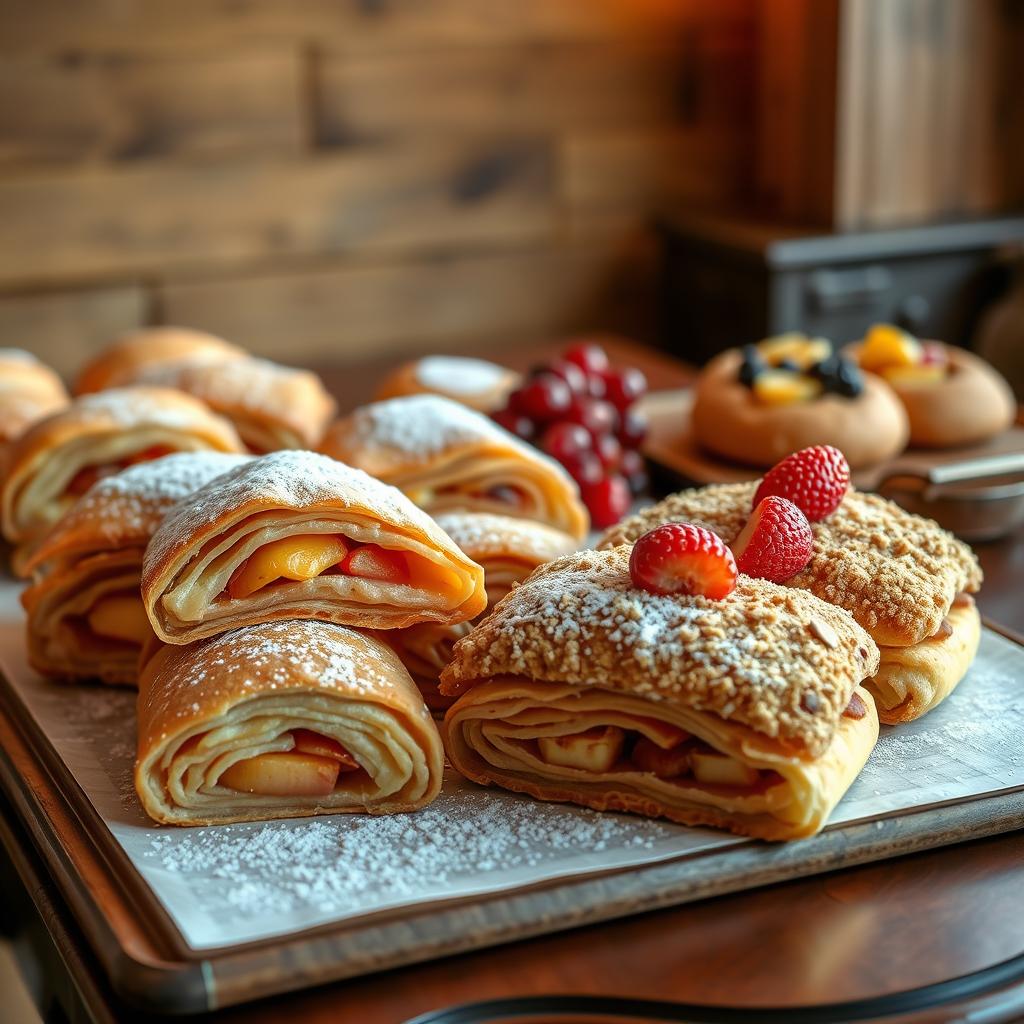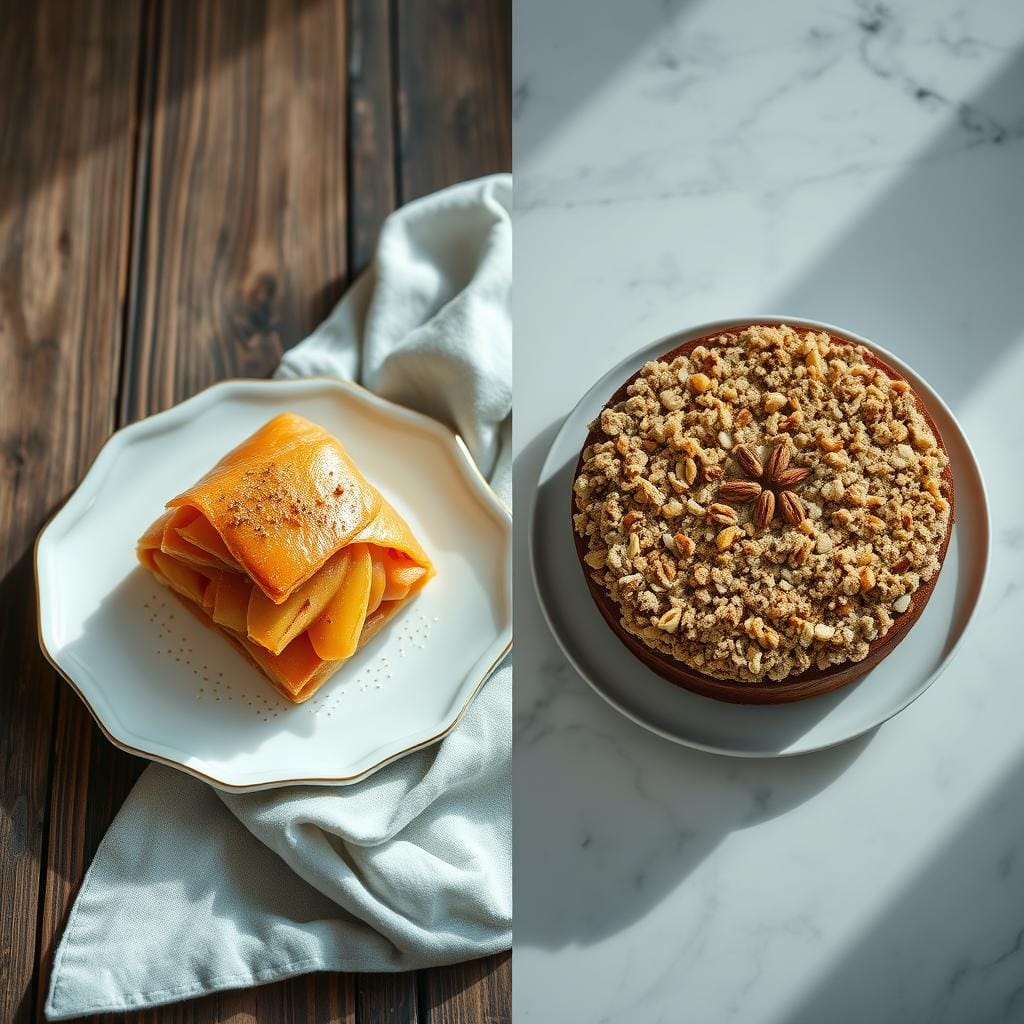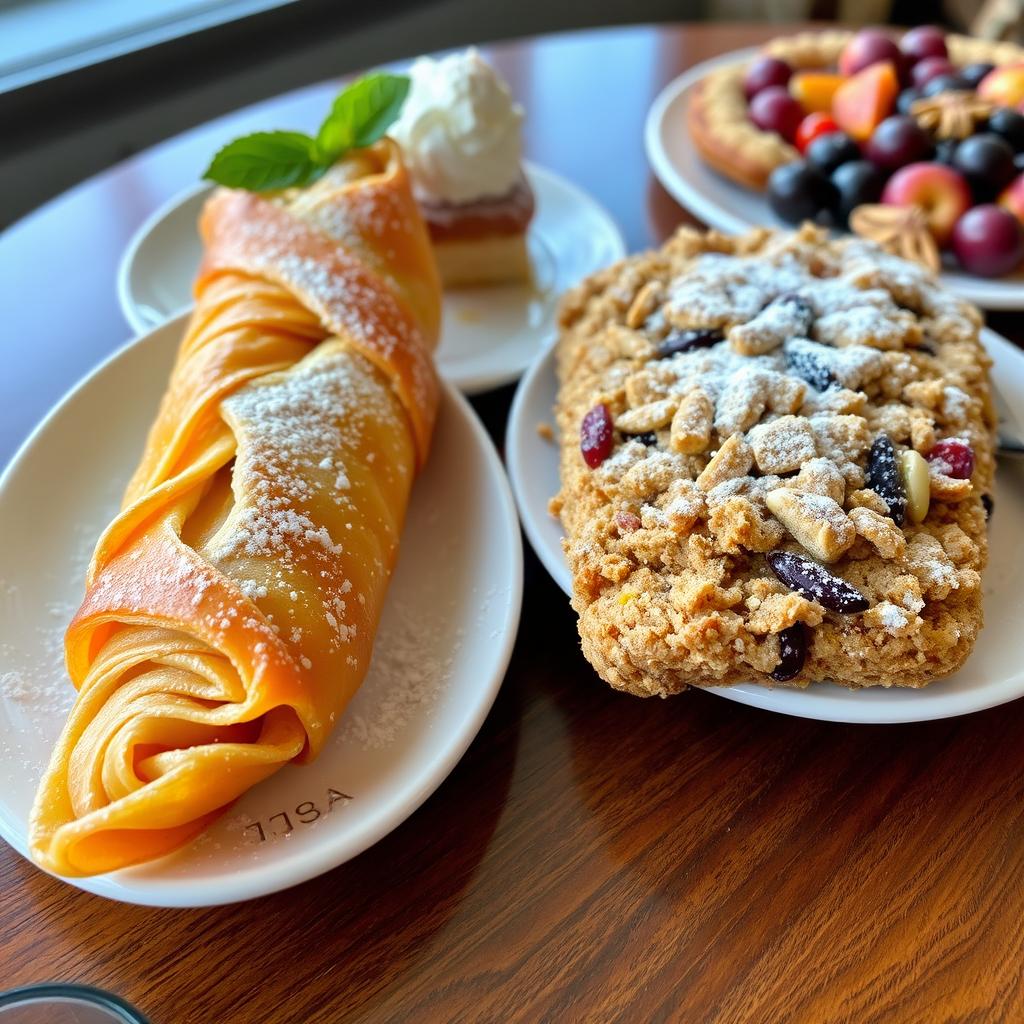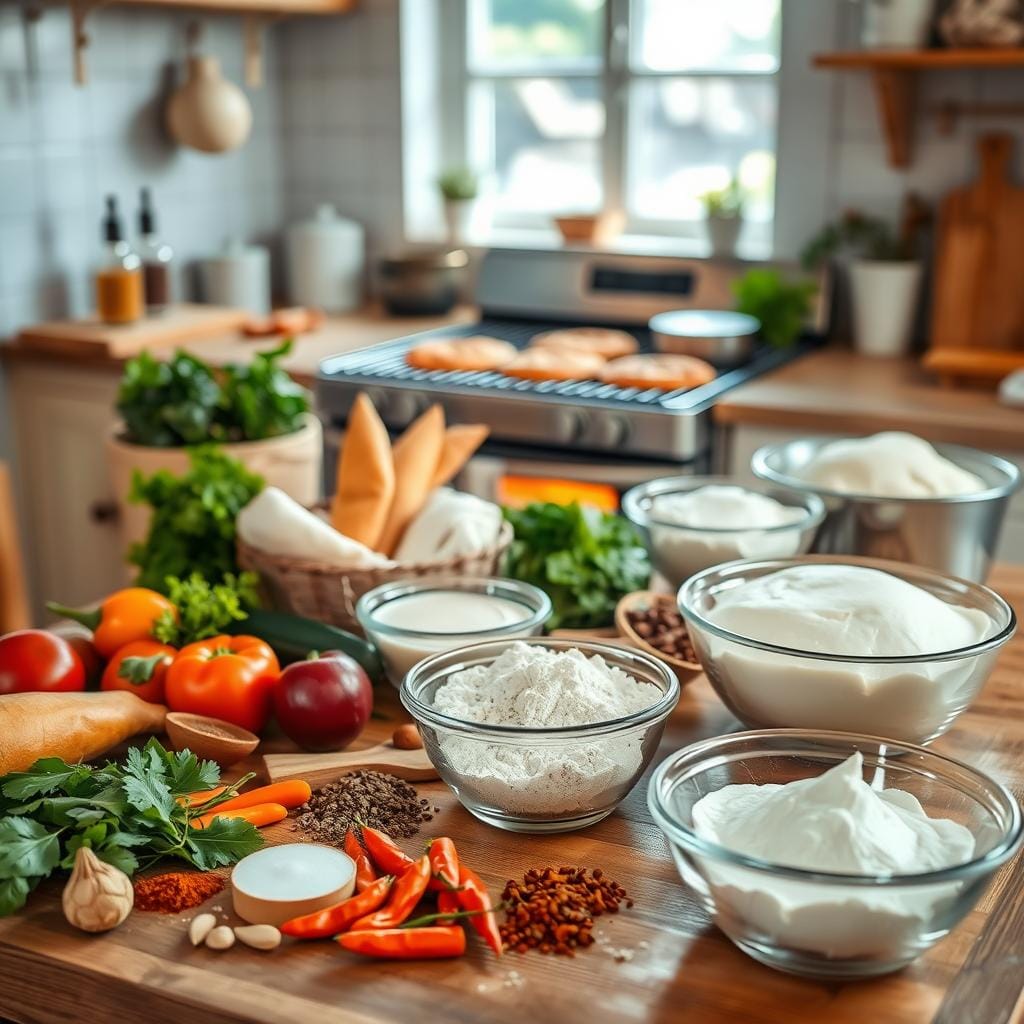As a passionate baker, I’ve always been fascinated by the difference between strudel and streusel. These pastries have won the hearts of many dessert lovers around the world. We’ll explore what makes these treats unique.
Growing up in a family that loves European cooking, I’ve seen the beauty of baking traditions. Strudel’s flaky layers and streusel’s crumbly topping remind me of my childhood. The smell of fresh pastries brings back memories of comfort and joy.

Key Takeaways
- Strudel and streusel are two unique European pastries with their own special qualities and ways of making them.
- Strudel is famous for its thin layers and many fillings. Streusel is loved for its crunchy, buttery topping.
- Both pastries have deep cultural roots and are now favorites in the world of sweets.
- Knowing the differences between strudel and streusel helps us enjoy these treats more. It lets us make better choices when we eat them.
- Learning about strudel and streusel’s origins, ingredients, and making techniques shows us the beauty of European baking.
Introduction to Traditional European Pastries
European baking traditions are rich and varied, showing the unique tastes of different countries. From the fine Austrian cuisine to the hearty German cuisine, these European pastries have grown over centuries. They are now a key part of today’s food world.
Origins of European Baking Traditions
The history of European baking traditions starts in the Middle Ages. Back then, monasteries and royal courts were key in improving pastry making. Each area developed its own baking traditions, shaped by local foods, culture, and religion.
Cultural Significance in Modern Cuisine
Today, traditional European pastries are still loved in the food world. They’re cherished for their tasty flavors and cultural importance. These baked goods show the rich history and variety of European cuisine. They’ve become favorites around the globe, inspiring new takes and twists.
| Country | Traditional Pastry | Signature Ingredients |
|---|---|---|
| Austria | Sachertorte | Chocolate, apricot jam |
| Germany | Schwarzwälder Kirschtorte | Cherries, chocolate, whipped cream |
| France | Croissant | Butter, yeast, flour |

“The art of pastry making is not just about creating delectable treats, but also about preserving the essence of cultural heritage.”
What’s the difference between a strudel and a streusel?
Traditional European pastries like strudel and streusel are often confused with each other. Yet, they have different origins, compositions, and textures. Knowing the differences between strudel and streusel can help you enjoy each dessert’s unique qualities.
Strudel comes from Austria and is known for its flaky layers. It’s made with a thin dough wrapped around fillings like apples or nuts. The dough is stretched and rolled to create its flaky texture.
Streusel, on the other hand, is a crunchy topping for cakes and muffins. It’s a mix of flour, sugar, and butter that’s sprinkled on top before baking. This creates a sweet and crunchy contrast to the soft pastry inside.
| Strudel | Streusel |
|---|---|
| Flaky, layered pastry | Crumbly, buttery topping |
| Originated in Austria | Commonly found in Germany and beyond |
| Filled with sweet or savory ingredients | Sprinkled over baked goods |
| Requires intricate dough-stretching technique | Simple mixture of flour, sugar, and butter |
Both strudel and streusel are loved in European cuisine. Knowing their differences helps us appreciate their unique flavors and artistry.

The Art of Making Strudel: A Deep Dive
Making a delicious strudel is like a work of art. It needs you to know how to make strudel dough and fillings well. Whether you’re experienced or new to baking, learning about this traditional European dessert can make you better at baking.
Traditional Strudel Dough Technique
To get the flaky dough of strudel right, you must handle the dough carefully. You need to stretch and roll it very thin. This makes the layers of strudel special compared to other pastries.
Common Strudel Fillings
Apple filling is a favorite, but you can also use many other things. Try different fillings like:
- Sweetened quark (a type of fresh cheese)
- Roasted nuts and cinnamon
- Raisins and rum-soaked breadcrumbs
- Savory options like spinach and feta
Essential Tools for Strudel Making
To make perfect strudel, you need some important tools. Get a strong rolling pin, a pastry cloth for stretching, and a seasoned baking sheet. These help your strudel dough turn golden brown.
“Strudel is a delicate dance between the crisp, flaky dough and the rich, indulgent filling. It’s a true testament to the art of pastry-making.”
Understanding Streusel: More Than Just a Topping
Streusel is a favorite topping in Europe, but it’s more than just a garnish. It’s a key part of many baked goods, adding a special texture and taste. This is true for coffee cakes and fruit pies alike.
The magic of streusel comes from its crumbly texture and the mix of nuts, cinnamon, and butter. These ingredients make a topping that’s both tasty and pretty. They turn simple pastries into something special.
Streusel isn’t just for topping. It can be the main attraction. European bakers love using it in desserts like streusel-topped muffins and streusel-filled coffee cakes. This mix of cake and streusel creates a unique pastry.
“Streusel is the unsung hero of the baking world, adding depth and character to so many beloved recipes.”
Streusel can make any baked good special. Whether it’s on an apple pie or in a coffee cake, it adds flavor and texture. It turns ordinary treats into something amazing.
| Ingredient | Purpose |
|---|---|
| Butter | Provides rich, creamy flavor and helps create the desired crumbly texture. |
| Flour | Binds the streusel together and contributes to the overall structure. |
| Nuts | Add a delightful crunch and nutty aroma to the streusel. |
| Cinnamon | Enhances the flavor profile with its warm, spicy notes. |
| Sugar | Provides sweetness and helps create the signature crumbly texture. |
Historical Origins: From Austria to Germany
The history of European pastries is filled with stories of strudel and streusel. These treats come from Austria and Germany, each with its own story. They show the beauty of different culinary traditions.
Austrian Strudel Heritage
Strudel, a layered pastry, started in Austria. It became popular in the 18th century among the Viennese aristocracy. It symbolized elegance in Austrian cuisine.
Today, bakers still make strudel with care. They use thin phyllo dough and fill it with sweet or savory ingredients. This keeps the tradition alive.
German Streusel Development
In Germany, streusel is a key part of German cuisine. It’s a buttery topping that’s been used for centuries. It’s found on many desserts and baked goods.
The streusel has grown from a simple topping to a complex ingredient. Now, it’s on cakes, coffee cakes, and stollen. It adds texture and flavor to these treats.
“The interplay between the flaky, layered strudel and the crumbly, buttery streusel is a testament to the rich culinary heritage of Europe.”
Key Ingredients That Set Them Apart
Traditional European pastries like strudel and streusel have special ingredients. These ingredients make their textures and tastes unique. From flour types to butter and fruit fillings, these differences are key.
Flour is a big difference. Strudel uses all-purpose flour for a soft, flaky dough. Streusel, on the other hand, has a crumbly mix of flour, sugar, and butter. It often includes whole-grain or nut flours for a richer taste.
Butter is also important. Strudel has lots of butter in the dough and filling. Streusel, however, uses butter mainly in its crunchy topping. This makes streusel’s top layer different from its soft inside.
| Ingredient | Strudel | Streusel |
|---|---|---|
| Flour | All-purpose flour for a supple, elastic dough | Whole-grain or nut flours for a heartier, crumbly texture |
| Butter | Generous amounts throughout the dough and filling | Primarily in the crumbly topping |
| Fillings | Diverse range of fruit fillings, such as apples, cherries, and raisins | Often features a simpler fruit filling or a crumble-like topping |
Fruit fillings also make strudel and streusel different. Strudel has a variety of fruits like apples and cherries. Streusel might have a simpler fruit or a crumbly topping.
Knowing these ingredient differences helps us see why strudel and streusel are so special. They are unique and delicious European treats.
“The secret to a perfect strudel or streusel lies in the careful selection and balance of its ingredients.”
Texture Comparison: Flaky vs Crumbly
Traditional European pastries like strudel and streusel have amazing texture differences. Strudel is known for its flaky pastry layers. Streusel, on the other hand, has a crumbly topping. These textures are not just pleasing to the senses but also show the skill and tradition in making each dessert.
Strudel’s Characteristic Layers
The secret to strudel’s flaky pastry is in the dough’s layering. Bakers stretch and layer the dough by hand. This makes the dough very thin and creates many pastry layers.
When baked, these layers become light and airy. They also add a satisfying crunch with every bite. The layers shatter in your mouth, enhancing the texture.
Streusel’s Distinctive Crumb
Streusel’s crumbly texture comes from a different method. It’s made by mixing butter, flour, and sugar until they form a coarse, crumbly mixture. This topping is then sprinkled over the dessert.
This creates a wonderful contrast to the soft base below. It adds a delightful texture to the dessert.
| Strudel | Streusel |
|---|---|
| Flaky Pastry Layers | Crumbly Topping |
| Achieved through hand-stretching and layering of the dough | Created by rubbing together butter, flour, and sugar |
| Satisfying crunch with each bite | Delightful textural contrast to the tender base |
Whether you love the flaky pastry layers of strudel or the crumbly topping of streusel, the texture differences are fascinating. They show the art and tradition in each dessert.
Popular Variations and Modern Adaptations
The pastries of strudel and streusel have evolved into many modern desserts and fusion baking creations. These beloved European treats have welcomed global influences to delight people worldwide.
One variation is the green tea strudel, with matcha-infused dough. Another twist is the chocolate-hazelnut streusel, blending German and Italian pastry variations. Bakers have also made savory strudels, mixing sweet and savory for a new taste.
Creative bakers have added exotic fruits, nuts, and spices to make unique modern desserts. You can find mango strudel, baklava-inspired streusel, and even vegan versions. These updates have won over a new generation of dessert lovers.
Strudel and streusel have become a blank canvas for fusion baking and culinary exploration. As new flavors inspire pastry variations, these classics remain a favorite in the world of modern desserts.
Tips for Perfect Strudel and Streusel at Home
Baking strudel and streusel at home can be very rewarding. It takes a few key techniques to get it right. Whether you’re new to baking or have experience, these baking tips and professional baker’s secrets will help you succeed every time.
Common Mistakes to Avoid
When baking strudel or streusel, watch out for common mistakes. These can ruin your homemade pastries. Here are some tips to avoid these errors:
- Don’t overwork the dough to avoid a tough texture
- Make sure to bake the pastry long enough to avoid sogginess
- Don’t overfill the strudel to prevent it from tearing
- Always chill the streusel topping before baking
Professional Baker’s Secrets
Improve your pastry techniques with these tips from experienced bakers:
- Use a mix of all-purpose and bread flour for the best strudel dough
- Chill the dough for at least an hour to make it easier to roll
- Brush the dough with melted butter or oil to keep it moist
- Add ground nuts or breadcrumbs to the streusel topping for extra crunch
- Bake the strudel and streusel at a lower temperature to prevent over-browning
With these baking tips and secrets, you’ll be able to make strudel and streusel that will wow your loved ones.
Serving and Storage Recommendations
Serving European pastries like strudel and streusel needs care. For strudel, cut neat slices to highlight its layers. Top it with whipped cream or vanilla ice cream for extra indulgence. Streusel is best in generous crumbles, alone or on a warm fruit dessert.
Keeping strudel and streusel fresh is crucial. Store strudel at room temperature, wrapped or in an airtight container, for up to three days. Streusel also stores well this way, but for crispness, reheat it in the oven before serving. Both pastries freeze well, keeping their flavors and textures for up to three months.
Follow these tips to keep your strudel and streusel delicious. They’ll delight your taste buds from start to finish.
FAQ
What’s the difference between a strudel and a streusel?
Strudel and streusel differ in texture, how they’re made, and what they’re filled with.
What is a strudel?
Strudel is a flaky pastry from Austria. It’s made by rolling out dough and filling it with apples, nuts, or sweet ingredients. Then, it’s rolled up and baked.
What is a streusel?
Streusel is a sweet topping. It’s made from butter, flour, and sugar. It’s sprinkled over cakes and pies for extra flavor and crunch.
How do the textures differ?
Strudel is soft and flaky with layers. Streusel is coarse and crumbly, adding crunch to baked goods.
What are the typical fillings for each?
Strudel is filled with apples, nuts, and cinnamon. Streusel is used as a topping, not a filling.
Where do these pastries originate from?
Strudel comes from Austria. Streusel has German roots.


